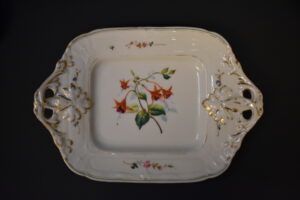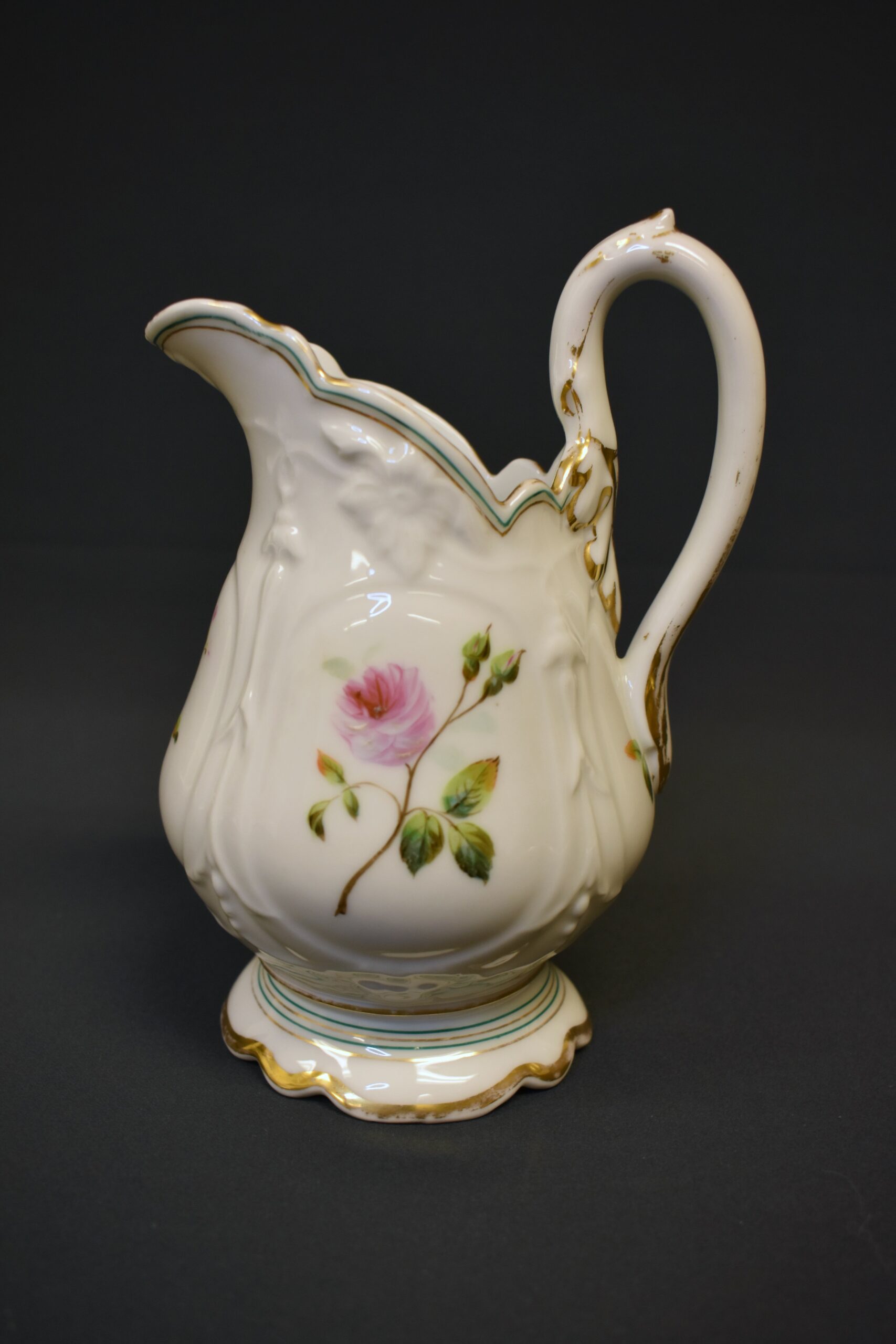













Hand Painted China Dishes, ca. 1848.
(Collection 2004.007)
A beautiful set of hand painted china dishes specially designed and imported from England. The set includes a creamer pitcher, cups and saucers, two sizes of plates (berry plates, which are more like small shallow bowls, and dessert plates), square serving trays, two different serving dishes (round and clamshell), and a compote (a tiered stand much like a cake stand.) The set features twelve different flowers. The flowers are in different stages of bloom and no two flowers on the set are alike, meaning no two dishes are the same.
The Allen family owned a prosperous woolen mill on the banks of Allen’s Creek (now called by its original Seneca name of Oatka Creek) in Mumford, New York. Oliver Allen I built his first mill in 1821 and it was one of the first mills west of the Genesee River. In 1829, he built the large stone mill called Allen’s Woolen Mill. He ran it until 1844 when his son Oliver Allen II (1823-1903) took over the running of the mill.”1 The Allen’s Woolen Mill was passed down through three generations and was known for its fine wool and quality fabric. However, it could not compete with the larger woolen mills in the northeast and closed in 1902.
Oliver II began courting Catherine Huchins Seaman (1827-1908), daughter of a wool merchant from Palmyra, New York, and they were married in 1848. Oliver designed this china set and sent the designs to England to be produced for his new bride. This was somewhat unusual as there were many standardized patterns to choose from, but he wanted something special for his future wife. Oliver and Catherine were well known for their hospitality in their home in Mumford2 and one can imagine this beautiful set being used by them. They had eight children, the oldest of whom was Frances Seymour Allen who passed the china to her daughter Ruth Campbell, grandmother of the donor. Oliver and Catherine were laid to rest in the Mumford Rural Cemetery under the largest monument in the cemetery. The tall stone plinth sits on a small rise and can be seen easily from the road.
These lovely dishes can be seen in the glassed-in china closet in Hamilton House, located in GCV&M’s gas-light district. At the time she donated the set of China the donor Virginia Ruth deRochemont stated, “When my great-great-grandfather, Oliver Allen, was courting his bride, Catherine Seaman, he sent to England for this lovely tea set. I was told by my grandmother, Ruth Campbell Shaler Gillespie, that her grandfather, Oliver Allen, designed the set for twelve with twelve different flowers. My mother, Virginia Shaler deRochemont, displayed the tea set attractively in the dining room in Newington, NH where we lived some of the time. I don’t recall it ever being used. My grandmother was an apartment dweller in New York City by my earliest memories, so I suppose these lovely dishes had been in storage for some years. The tea set came west with me when the family homestead in Newington was sold.”3
The 19th century saw a change in dining customs. In the 17th and 18th centuries rural families usually had a large pewter platter from which the meal was served and ate with “spoons, knife blades, or their fingers; forks were a rarity.”4 It was only in the 19th century that rooms made specifically for dining became more common in a house. As the century moved on dining customs and the dishes used became more and more complex.
These dishes sit in the china closet directly across from the Hamilton House dining room where the table is set up for an elaborate dinner party. It’s easy to imagine guests in their finery and the table laden with dishes and from all accounts the Allen’s enjoyed hosting guests. By this point in the mid-1800s the table would most likely contain a multitude of specialized dishes and utensils. “Many articles were designed for only a single function. Meat, pickle, and butter dishes, lemonade cups, asparagus tongs, knife rests, celery vases, a mustard tureen, egg cups.”5 The GCV&M has a large variety of tableware from the 19th century including pickle forks, tiny miniature strawberry forks, custard dishes, berry dishes, sauce dishes, waste bowls, saltcellars, and dishes and utensils of all shapes and sizes.
Cookbooks gained rising popularity in the 1830s and ‘40s. “Among the most popular were Lydia Maria Child’s American Frugal Housewife (1832) and Catherine Beecher’s Treatise on Domestic Economy (1841).”6 These books were filled with remedies, household management and interior decoration, helpful information for an organized home, and of course recipes, then called receipts. These receipts would have come in handy as multiple courses in addition to desserts were served.
It is easy to get swept away in the finery of the dining room in the luxuriously furnished Hamilton House, but it is important to remember that these items and customs were for the middle and upper classes. Social aspects, class structure, and race affected what the table customs and needs were. Farming families would have been more concerned with the food that was served than what that food was served on. That isn’t to say that more affluent farmers would not have had nice tea sets and a few decorative dishes, but smaller farms would not have had the sheer amount of both food and dining implements.
The pioneers of the time would have thought even less of the multitude of different types of dishes and cutlery. Laura Ingalls Wilder writes in her beloved Little House series of books of Laura and Mary’s absolute joy at receiving their Christmas gifts, one of which was a new tin cup. While this may not sound exciting in our current times, having your very own cup would have been thrilling for a young pioneer girl. “Think of having a cup and a cake and a stick of candy and a penny… Mary and Laura looked at their beautiful cakes and played with their pennies and drank water out of their new cups.”7
The enslaved of the American South had a vastly different experience from any of those listed above. Booker T. Washington writes that his family got their food like “dumb animals get theirs. It was a piece of bread here and a scrap of meat there…a cup of milk at one time and some potatoes at another. Sometimes a portion of our family would eat out of the skillet or pot, while someone else would eat from a tin plate held on the knees using nothing but hands…to hold the food.”8
My own ancestors were poor farmers who lived in the hills of the Ozark Mountains. Had I lived then I certainly would not have experienced material goods so fine as these. Even so, it is an exciting thing to think of a fancy dinner party where you would wear your finery and I particularly love Hamilton House because of this. The interpretation sets you up to imagine that. As it should. But it is also important for visitors to understand that this is an example of one class of people. There were a vast many others that lived quite differently.
- George E Slocum, Wheatland, Monroe County, New York: A Brief Sketch of Its History (Scottsville, New York: Isaac Van Hooser, 1908). ↩︎
- Slocum, 98. ↩︎
- From the catalog record in the GCV&M database. ↩︎
- Jane C. Nylander et al., Windows on the Past: Four Centuries of New England Homes (Boston, Massachusetts: Historic New England, 2009). ↩︎
- Nylander et al., 181. ↩︎
- Nylander et al., 181. ↩︎
- Laura Ingalls Wilder, Little House on the Prairie (New York, New York: Harper Collins, 1971). ↩︎
- Booker T. Washington, Up from Slavery (New York, New York: Viking Penguin Inc., 1986). ↩︎













